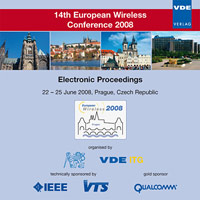An Optimized Relay Self Selection Technique for Opportunistic Routing in Mobile Ad Hoc Networks
Konferenz: European Wireless 2008 - 14th European Wireless Conference
22.06.2008 - 25.06.2008 in Prague, Czech Republic
Tagungsband: European Wireless 2008
Seiten: 7Sprache: EnglischTyp: PDF
Persönliche VDE-Mitglieder erhalten auf diesen Artikel 10% Rabatt
Autoren:
Baccelli, François; Blaszczyszyn, Barlomiej (INRIA/ENS, Paris, FRANCE)
Ermel, Erwan (LIP 6 University of Paris VI, Paris, FRANCE)
Mühlethaler, Paul (INRIA, Le Chesnay, FRANCE)
Inhalt:
In this paper we present a new routing technique which can operate on mobile ad hoc networks. This technique is opportunistic in the sense that each packet on its (specific) route from an origin (O) to a destination (D) at each hop takes advantage from the current pattern of nodes who captured its recent (re)transmission to choose the next relay. Note that this is unlike in conventional routing protocols, which first predetermine the relays on a route from O to D, e.g. with a shortest path algorithm, and then let a given medium access (MAC) protocol, e.g. Carrier-Sense Multiple Access (CSMA), deliver all the packets using this route. Moreover, in our technique, the current transmitter of a given packet does not know its next relay a priori, but the nodes who capture this transmission (if any) perform a self selection to chose the unique packet relay node and acknowledge the transmitter. Finally, the above relay self selection procedure is optimized in the sense that it is the node that optimizes some given utility criterion, e.g. minimizes the remaining distance to D, which is chosen as the relay. The primary goal of this paper is to explain how relay self selection can be achieved. Moreover, we show that this routing technique works well with various MAC protocols which may be controlled multiple access schemes or random access schemes. More precisely, assuming two different MAC protocols: Aloha and CSMA, we use simulations to compare the performance of this new routing technique to conventional shortest path routing. In this particular study we assume that the self selection chooses the relay that minimizes the remaining distance to the destination. This criterion requires that the nodes know their geographic positions. However, as we show, if only a small fraction of the nodes in the network know their positions exactly, e.g. using GPS, and provide this information to the remaining to nodes to let them estimate their positions, our proposed technique still works very well and outperforms conventional routing techniques.


